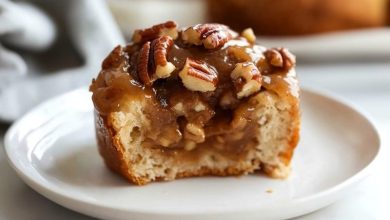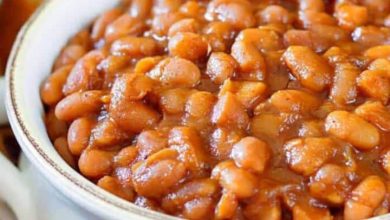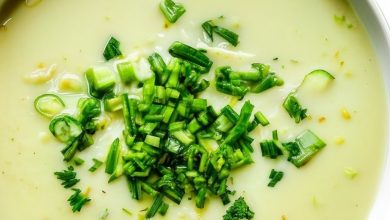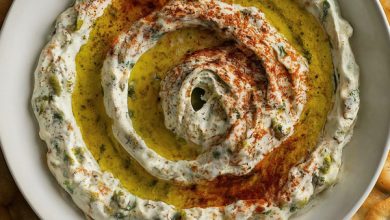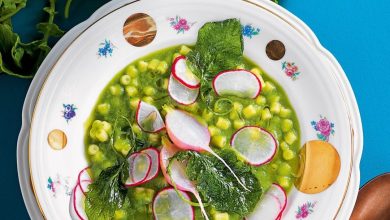Savory Moroccan Lamb Tagine with Prunes
Introduction
Lamb Tagine with Prunes, as featured on Love With Recipes, is a classic North African dish that embodies a symphony of flavors—rich, savory, sweet, and aromatic all at once. This culinary masterpiece originates from the Maghreb region, especially Morocco, where slow-cooked stews are integral to traditional cuisine. The dish combines tender lamb shanks with an infusion of exotic spices such as ras el hanout, saffron, and cinnamon, complemented by the subtle sweetness of prunes and hearty vegetables like pumpkin and chickpeas. The preparation requires patience and attention to detail, but the result is a deeply flavorful, aromatic, and satisfying meal that elevates everyday dining into an extraordinary experience.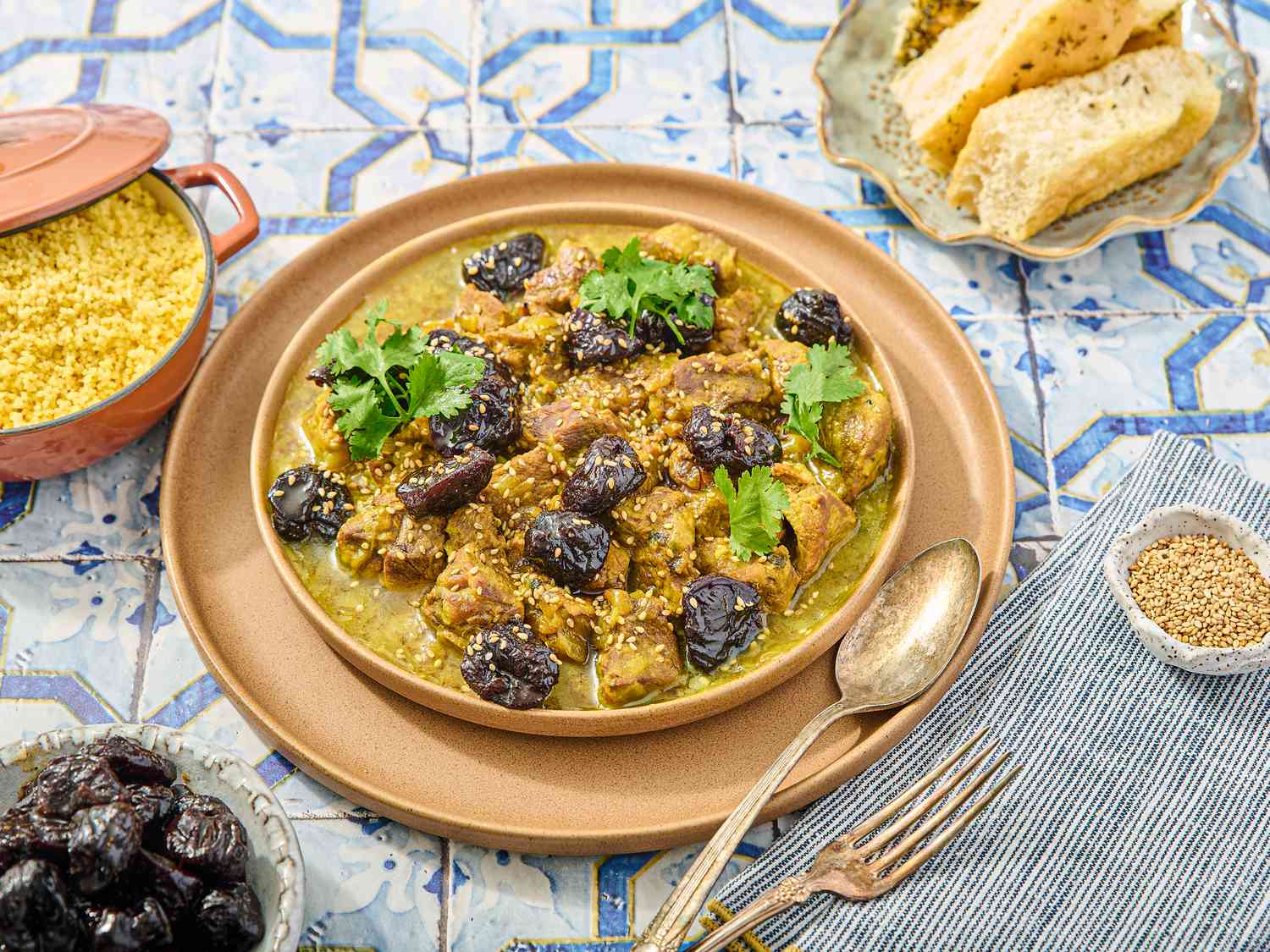
The process of making this tagine involves marinating the lamb, slow braising to achieve melt-in-the-mouth tenderness, and a careful balancing of spices and sweetness to develop layers of flavor. The dish is perfect for special occasions or when you desire a comfort food that also transports your taste buds to distant lands. For those who love culinary adventures, this recipe offers a perfect opportunity to explore traditional Moroccan flavors in your own kitchen.
Understanding the cultural significance of the ingredients—such as saffron, which is highly prized and often expensive, or ras el hanout, a spice blend that varies regionally—adds depth to the cooking process. This dish encapsulates the warmth of home-cooked Moroccan cuisine, bringing families and friends together to share a memorable meal. It is also highly adaptable, allowing for substitutions based on dietary preferences or ingredient availability.
At Love With Recipes, we aim to guide you through every step of this process with detailed insights, tips, and background information to enhance your culinary journey. Whether you are a seasoned chef or a kitchen novice, this comprehensive guide will help you master the art of making a traditional Lamb Tagine with Prunes, ensuring a delightful dining experience for all.
Time
- Prep Time: 45 minutes
- Cook Time: 3 hours
- Total Time: 3 hours 45 minutes
Needed Equipment
Essential Kitchen Tools
- Large heavy-based Dutch oven or tagine pot with lid
- Sharp chef’s knife
- Cutting board
- Measuring spoons and cups
- Mixing bowls
- Wooden or silicone spoons for stirring
- Fine-mesh strainer or slotted spoon (for skimming fat)
- Refrigerator for marinating and resting
- Slow cooker or oven (optional, for alternative cooking methods)
- Kitchen thermometer (optional, for checking lamb temperature)
- Serving dishes and utensils
- Small saucepan for preparing spices (optional)
Tags
Flavor profile: savory, aromatic, sweet, hearty
Cooking methods: braising, slow cooking, simmering
Dietary notes: gluten-free, dairy-free (if butter is omitted), can be made vegan with substitutions
Serving Size
This recipe yields approximately four generous servings, making it ideal for family dinners or small gatherings. Each serving combines a hearty portion of lamb with vegetables, pulses, and flavorful sauce, providing a balanced and satisfying plate.
Difficulty Level
Intermediate. This recipe involves multiple steps, including marination, browning, slow cooking, and flavor balancing. However, with patience and attention to detail, it becomes an achievable and rewarding culinary project for home cooks with some experience in braising or stewing dishes.
Allergen Information
- Common allergens involved: none explicitly, but be aware of potential cross-contamination with gluten or nuts depending on spice blends or ingredients used.
- Saffron: a spice derived from the flower stigmas, may cause allergic reactions in sensitive individuals.
Dietary Preference
This recipe is naturally gluten-free and can be adapted to vegan or vegetarian diets by substituting lamb with hearty vegetables or plant-based proteins, and ensuring the use of suitable spice blends and broths.
Course
Main Course
Cuisine
North African / Moroccan
Ingredients
Ingredient List
| Ingredient | Quantity | Notes |
|---|---|---|
| Lamb shanks | 1 1/2 pieces | preferably meaty and well-marbled for flavor |
| Onions, grated and sliced | 3 large | for marination and flavor base |
| Ras el hanout spice mix | 1 tablespoon | store-bought or homemade spice blend |
| Butter | 2 tablespoons | divided for marinating and sauce |
| Saffron threads | Pinch | steep in warm water for infusion |
| Cinnamon stick | 1 stick | adds warmth and aroma |
| Olive oil | 1 tablespoon | for searing and cooking vegetables |
| Sugar | 1 teaspoon | for caramelization of onions |
| Chopped tomato | 1 medium | fresh or canned |
| Canned chickpeas | 2 cups | drained and rinsed |
| Pumpkin or squash, diced | 2 cups | preferably butternut or acorn |
| Prunes, pitted | 1 cup | adds sweetness and depth |
| Salt and pepper | to taste | adjust seasoning as needed |
Instructions
1. Marinate the Lamb Shanks
Begin by preparing the lamb shanks for marination. In a large mixing bowl, combine the grated onions, ras el hanout spice mix, salt, and pepper. Mix thoroughly to create a flavorful paste. Coat each lamb shank evenly with this mixture, ensuring the marinade penetrates the surface for maximum flavor. Cover the bowl tightly with plastic wrap or transfer the coated shanks into a resealable plastic bag, pressing out excess air. Refrigerate for at least 30 minutes, but preferably up to 2 hours, to allow the flavors to develop and tenderize the meat.
2. Browning the Lamb
After marination, retrieve the lamb shanks from the refrigerator. Heat the heavy-based Dutch oven or tagine pot over medium heat. Add 1 tablespoon of butter, allowing it to melt and coat the bottom evenly. Carefully place the lamb shanks into the hot pan, searing each side until golden brown—about 4-5 minutes per side. This step locks in juices and adds depth to the final flavor profile. Use tongs or a slotted spoon to turn the meat, ensuring all sides are browned evenly.
3. Infusing with Spices and Simmering
Once the lamb is browned, add the saffron threads to the pan, along with the cinnamon stick. Pour in enough water to just cover the meat—this will create the base for slow braising. Bring the liquid to a gentle boil, then reduce the heat to low, cover, and simmer gently for approximately 1 1/2 hours. During this time, the lamb will become tender, flavorful, and infused with aromatic spices. Check periodically, skimming off any surface fat with a fine-mesh strainer or slotted spoon to keep the sauce clear and rich.
4. Cooling and Removing the Meat
After cooking, allow the lamb shanks to cool slightly in the liquid. Carefully remove them from the pot, discarding any excess fat, gristle, or bones. Once cooled enough to handle, strip the meat from the bones with forks or your fingers, ensuring you remove any connective tissue or unwanted bits. Reserve the cooking liquid for the sauce and flavor base.
5. Preparing the Sauce and Vegetables
In a separate medium pan, melt the remaining 1 tablespoon of butter along with 1 tablespoon of olive oil over medium heat. Add the sliced onions and sprinkle with sugar, a pinch of salt, and pepper. Cook, stirring occasionally, for about 15 minutes until the onions are caramelized and golden. This step enhances sweetness and adds complexity to the dish.
Add the chopped tomato to the caramelized onions and cook for another 5 minutes until softened. Pour in the reserved cooking liquid from the lamb, bringing it to a gentle boil. Stir in the chickpeas and diced pumpkin or squash, allowing the flavors to meld. Return the shredded lamb meat to the pan, stirring gently to combine all ingredients.
6. Final Simmer and Thickening
Reduce the heat to low, cover the pan, and simmer for 15 minutes to allow the flavors to deepen. Then, uncover and cook for an additional 15-20 minutes until the sauce thickens to your desired consistency. During this final step, taste and adjust seasoning with salt and pepper, and ensure the vegetables are tender and the lamb is fall-apart soft.
7. Serving
Lamb Tagine with Prunes is best served hot, accompanied by traditional Moroccan bread such as pita or lavash. For an extra layer of heat, consider offering harissa sauce on the side. Garnish with fresh herbs like cilantro or parsley if desired. The dish pairs beautifully with couscous or rice, which absorb the flavorful sauce.
Preparation Tips
- Marination: For enhanced flavor, marinate the lamb shanks overnight in the refrigerator, allowing the spices to penetrate deeply.
- Skimming Fat: To keep the sauce light and clear, refrigerate the cooking liquid overnight and remove the solidified fat before proceeding with the sauce.
- Slow Cooking: For convenience, use a slow cooker set on low for 6-8 hours after browning the meat; adjust cooking times accordingly.
- Ingredient Quality: Use high-quality saffron and fresh spices for the most authentic and vibrant flavor.
- Vegetable Variations: Feel free to add carrots, potatoes, or other seasonal vegetables to customize the dish.
Nutritional Information
| Nutrient | Per Serving | Daily Value % |
|---|---|---|
| Calories | 1128.1 kcal | 56% |
| Fat | 52.7 g | 81% |
| Saturated Fat | 21.9 g | 110% |
| Cholesterol | 347.6 mg | 115% |
| Sodium | 457.2 mg | 19% |
| Carbohydrates | 56.5 g | 19% |
| Fiber | 7.5 g | 30% |
| Sugar | 21.9 g | 24% |
| Protein | 105.1 g | 210% |
Tips and Tricks
- Flavor Depth: Toast the ras el hanout spices lightly in a dry skillet before adding to intensify their aroma.
- Sweetness Balance: Adjust the amount of prunes and sugar based on your preference for sweetness or acidity.
- Spice Variations: Incorporate additional spices such as ginger, turmeric, or cumin for a personalized flavor profile.
- Cooking Liquids: Use homemade or high-quality broth instead of water for added richness.
- Serving Temp: Serve the tagine hot, but leftovers can be gently reheated for subsequent delicious meals.
Add-ons
- Fresh herbs like cilantro or parsley for garnish
- Harissa or chili paste for extra heat
- Yogurt or sour cream dollop for cooling contrast
- Toasted almonds or sesame seeds for crunch
Side Dishes
- Couscous or saffron rice
- Warm Moroccan bread such as pita or khobz
- Steamed or roasted vegetables like carrots or zucchini
- Salad with lemon vinaigrette or preserved lemon slices
Improvements
- Vegetarian Version: Substitute lamb with hearty vegetables like eggplant, carrots, and mushrooms, and add plant-based protein sources.
- Spice Intensity: Adjust spices to suit your taste for milder or more intense flavor profiles.
- Cooking Method: Use a pressure cooker to reduce cooking time while maintaining tenderness.
- Additional Sweetness: Incorporate dried apricots or dates for variety in sweetness.
Save and Store
Leftovers can be stored in an airtight container in the refrigerator for up to 3 days. For longer storage, freeze in portions for up to 3 months. Reheat gently on the stovetop or in the microwave, adding a splash of water or broth to restore moisture. To preserve the flavors, store the sauce separately from the cooked lamb and vegetables if possible.
Refrigerated or frozen tagine tastes even better the next day as the flavors meld and deepen. For best results, reheat slowly and avoid boiling to prevent overcooking the meat.
FAQ
Can I make this dish ahead of time?
Absolutely. In fact, preparing the lamb shanks a day in advance allows the flavors to fully develop. After cooking, refrigerate the lamb and sauce separately, then reheat gently before serving.
Can I substitute lamb with chicken or beef?
Yes, but cooking times will vary. Chicken thighs work well and require less cooking time, while beef shanks can be braised similarly but may need longer simmering for tenderness.
Is ras el hanout available in stores?
Most Asian and Middle Eastern grocery stores carry ras el hanout. Alternatively, you can make your own spice blend using cumin, coriander, turmeric, cinnamon, ginger, and other spices.
What can I use instead of prunes?
Apricots, dates, or dried figs are good substitutes, providing different yet complementary sweetness and texture.
Conclusion
Making Lamb Tagine with Prunes is a rewarding culinary adventure that combines traditional Moroccan techniques with a personal touch. The slow braising process ensures tender meat infused with complex spices, while the addition of prunes lends a subtle sweetness that balances the savory elements. This dish not only impresses with its vibrant aromas and deep flavors but also offers a comforting and hearty meal perfect for sharing. Remember, patience is key—allowing the flavors to meld over slow cooking results in a truly authentic experience. At Love With Recipes, we hope this comprehensive guide inspires you to bring a taste of Morocco into your home kitchen, elevating your cooking repertoire and delighting your loved ones with every bite.
References
- Moroccan Cooking: Traditional Recipes and Techniques, by Fatima G. (2008)
- Spice Blends of the Maghreb, by Sarah D. (2015)

